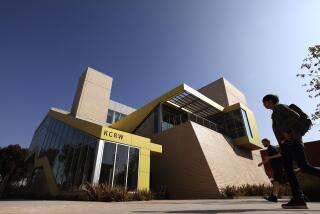Coronavirus upended local TV news overnight. It may never be the same again
For more than two years, Rita Garcia has co-hosted KTTV Fox 11’s “Good Day L.A.” from the station’s vast set in West Los Angeles, delivering headlines and news while engaging in breezy banter with the rest of the team providing updates on weather and traffic.
That dynamic turned upside down last Monday.
While most Angelenos were sleeping, Garcia and a few other members of the news operation were scrambling to set up an impromptu studio in an upstairs bedroom of her Mid-City home, where she was planning to co-anchor the three-hour newscast, which airs weekdays at 4 a.m. It was part of the station’s move to incorporate social distancing and other preventive measures into its operation in the wake of the coronavirus outbreak.
There were some tense moments. Garcia’s neighborhood had been hit by a power outage a few days earlier, and the internet needed to connect wireless hookups was still spotty. But aided by personal “hot spots” from smartphones and computers, Garcia was able to host from the bedroom while fellow anchor Dan Cohen hosted from the “Good Day L.A.” set.
“It felt like the first day of school,” an excited Garcia said in a phone interview a few hours after the broadcast. “There were three phones, two laptops, an iPad and a camera. It was a historic moment. I always say teamwork makes the dream work, but in this case, the hot spots did.”
The broadcast was just one example of how Los Angeles stations have had to adapt quickly to the new normal of programming news while adhering to government mandates designed to stop the spread of the virus. While TV audiences continue to tune in to CNN and MSNBC for the latest national updates, they are also relying on broadcasters closer to home to apprise them of what’s going on specifically in their communities.
Tracking similar growth in ratings for the networks’ nightly news broadcasts, those audiences have grown sharply in the last two weeks, compared to the first two weeks in March. According to Nielsen, the combined viewership of the 5 p.m. newscasts on KCBS, KNBC, KABC and KTTV has increased 42%, with the 6 p.m. newscasts of KCBS, KNBC, KABC and KTLA up 44%. KCAL’s three-hour evening block has seen a viewership bump of 36%.
The on-air talent at these stations are on the front lines just like first responders, and they must deal with their own vulnerabilities, personal difficulties and safety while projecting authority, calm and poise in front of the camera.
Even for a local news scene familiar with and accustomed to covering riots, earthquakes, floods and wildfires, the coronavirus outbreak is uncharted territory. TV newsrooms are traditionally frenzied hubs of activity filled with writers, reporters, producers and others in close quarters. Most of those hubs have now gone eerily quiet.
In addition to social distancing, TV journalists are working remotely, wearing gloves, using extended mikes to conduct interviews and concentrating on stories closer to their residences. Fewer people and technicians are working in the studios and newsrooms. Meteorologists are doing weather reports from their living rooms. Instead of commuting to stories together in a news van, reporters and news crews now travel separately.
Makeup and hair people who are still at the stations are wearing gloves and masks as they prepare anchors for the camera. Reporters are permitted to turn down an assignment if they feel it’s unsafe.
Said Tara Finestone, vice president and news director of sister stations KCAL and KCBS: “The number one priority is the health and safety of our employees. That’s always been a 24/7 job, but it’s even more so now. This is an uncertain time, and we’re dealing with a new normal of working remotely. It’s changed dramatically how we work, how we gather and how we present the news.”
KTLA Channel 5 general manager Janene Drafs said: “Our people are just like our viewers. They’re going through their own personal situations while also trying to adjust and deal with their professional requirements.”
Though there have been some rough spots, several news directors and executives so far have been encouraged by the transition. Some have even speculated that the shift might revolutionize local news.
“I believe this is actually going to change our industry in terms of how news is gathered, reported and assembled,” Finestone said. “Even if the order is lifted, I don’t know if we’ll go back to working the same way. We’re finding out that a lot of what we’re doing at home in some respects is more efficient. We’re forced to be present and talk to each other.”
Bill Lamb, senior vice president and general manager of KTTV Fox 11 and KCOP, said the transition has been “like changing a tire in the middle of a highway. It’s moving at 140 miles per hour. We’ve done a 10-year acceleration in two weeks. It proves we can be extremely flexible when there is a need. Morale is very high. It’s a very energizing time for us considering how serious this situation is.”
Veteran TV anchor Pat Harvey said the current dilemma is a defining moment in her professional career.
“This is different than any story I’ve ever worked on,” said Harvey, who co-anchors the KCBS 5, 6 and 11 p.m. newscasts and has covered stories in her decades-long career ranging from the civil war in El Salvador to the 2018 mass shooting at the Borderline Bar and Grill in Thousand Oaks, where 11 people were killed.
“I’m approaching this the way I always have,” Harvey said. “I’ve always cared, but I do even more so now. We are delivering news of the utmost difficulty in a calm manner. People really need this life-changing information.”
While all KCBS reporters are working remotely, Harvey and co-anchor Jeff Michael have continued to helm their broadcasts from the station’s Studio City headquarters. The two now are separated at far ends of the anchor desk instead of sitting next to each other. “The first day we did that, I waved at him,” Harvey said with a chuckle. “Because we are so far apart, we have this tendency to look at each other and have more conversation. It’s very natural.”
Evelyn Taft, who reports the weather for KCAL’s evening block, is still getting used to her new reality — doing reports from the family room of her Hollywood home, which has been converted into a mini-studio.
“Never in a million years did I ever think I could do my job from home,” said Taft, who has been at the station for 10 years. In addition to the TV in the room, she has a monitor replete with graphics and maps.
“There is a silver lining to this — I get to be with my kids all day,” Taft said. “But it’s hard. My kids are 4 and 6, and it looks like they’re going to be out of school for the rest of the school year. So it’s blurring the line between being a mom and meteorologist and on-air talent.”
Her reports have now become a family affair. “I first go on air at 8, and my kids want to be part of it. I don’t put them on camera — I put them on the couch. They know they have to be quiet, but that doesn’t always work out. My daughter usually falls asleep on the couch.”
For Garcia, who was previously at Fox’s affiliate station in Houston, projecting calm and authority has been a priority even though she has had her own harsh reality to deal with: She was forced to cancel her planned March 21 wedding.
“We were getting married abroad, and were going to travel internationally, so I know what people are going through in terms of making life-changing decisions,” Garcia said. “I have to put all my worries and the things I have going on in my personal life aside and make it about the viewers. When we’re all able to bond over a story like this, that’s when compassion comes across. I truly know what they’re feeling.”
One key to facing the challenges of delivering the news from home? A sense of humor.
KTLA general assignment reporter Ellina Abovian was out in the field when her nanny quit, concerned Abovian might get infected and bring the virus home. The station set her up to work at home.
On the second day of reporting, Abovian was completing a live remote about increasing unemployment when her toddler came up to her asking for a patik, which means “hug” in Armenian. The child then knocked over the camera, bringing a quick end to the report.
“And it was going so well,” Abovian said with a smile as she righted the camera.
While instituting many of the same adjustments as other stations, Spanish-language network Univision has taken its own specific measures to better serve its viewers. For instance, Univision’s local station KMEX-TV Channel 34 does not carry the daily live press briefings from state and local government officials. Said KMEX general manager Luis Patino: “For one, we think there’s a little bit of fatigue around them. Also, and most important for us, they’re not in Spanish. They don’t even have Spanish subtitles.”
Instead, the briefings are recapped in Spanish in real time by the station, with the news operation providing context that will have more resonance for viewers’ communities, Patino said.
About 90% of the KMEX news crew, including weather and entertainment reporters, are working remotely. The main anchor team has been split up. Leon Krauze is in the studio while Andrea Gonzalez is anchoring from her home. They are on a rotation in which they switch off working from home every two weeks.
Reporters continuing to work in the field have their own problems. They are often approached by people who want to talk to them, shake their hand or high-five. The news crews have had to put up signs asking people to keep their social distance.
“Folks really feel that connection with our reporters, and we really love that,” said KTLA vice president and news director Jason Ball. “We do want to talk to them, but we have to be careful. We can also set up perimeters around the reporters.”
KCBS’ Harvey has experienced this upside of the new normal:
“I’m cooking a lot more, and I think my family likes that,” she said. “And we have our grandchildren staying with us, so that’s nice. This makes you think about your loved ones and how important it is to understand what we all have to do to get through this. It might sound clichéd, but in terms or us being in this together, we really are. No one is immune.”
More to Read
The complete guide to home viewing
Get Screen Gab for everything about the TV shows and streaming movies everyone’s talking about.
You may occasionally receive promotional content from the Los Angeles Times.







